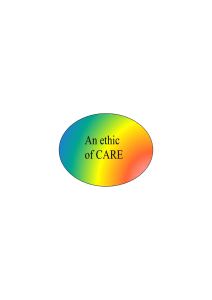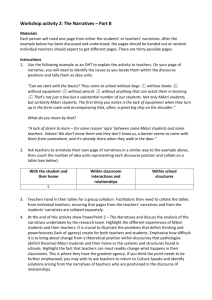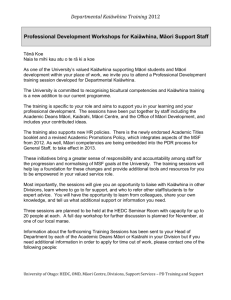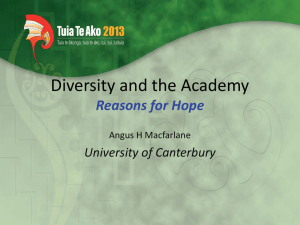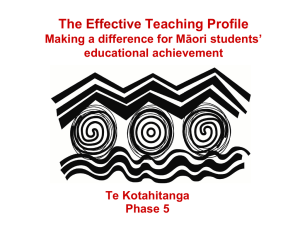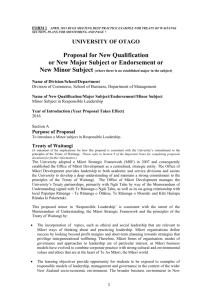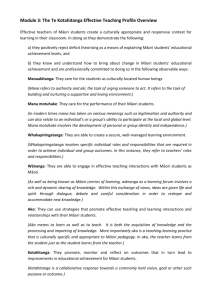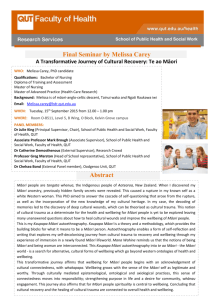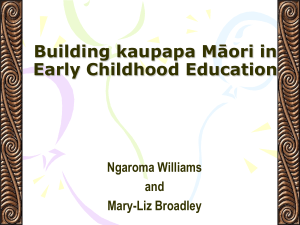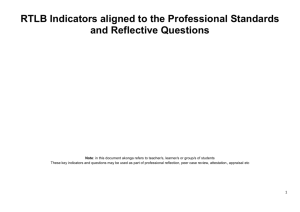The Main Influences on Māori Students
advertisement
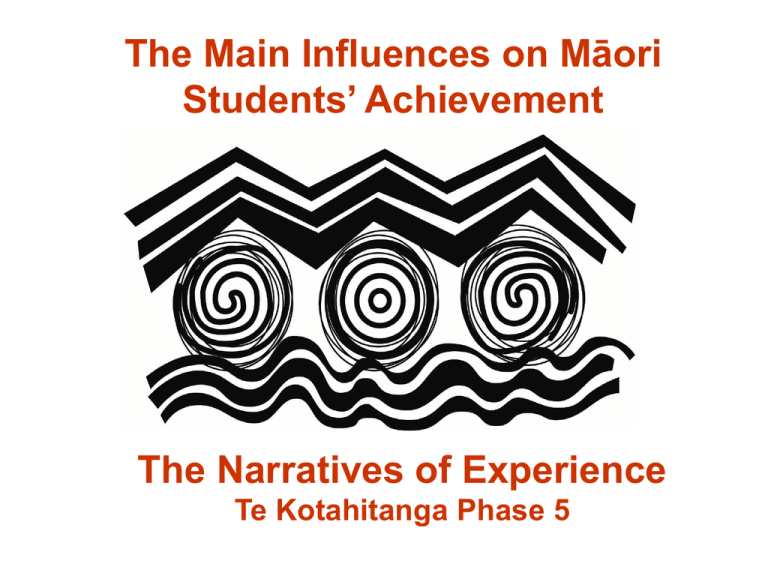
The Main Influences on Māori Students’ Achievement The Narratives of Experience Te Kotahitanga Phase 5 Interviews-as-chat with … Year 9 and 10 Māori students in five secondary schools: • Non-engaged Māori students • Engaged Māori students • Their whānau • Their teachers • Principals Why use Narratives of Experience? Students’ experience and understandings: • Can improve educational practice by providing teachers with an understanding of how students see the world (within school and in the community) • Can help teachers make what they teach more accessible to students • Can contribute to the ways teachers view teaching and use more collaborative processes • Can make students feel more empowered in the classroom as active participants in the classroom planning • Can motivate students to participate constructively in their education • Can inform educational reform • Can provide a means whereby students’ prior learning and cultural understandings can be brought into the classroom. (Bishop, & Glynn, 1999; Cook-Sather, 2002) For more information about Narratives of Experience Cook-Sather, A. (2002). Authorizing students’ perspectives: Towards trust, dialogue, and change in education. Education Researcher, 31, (4), 3-14. Bishop, R. & Glynn, T (1999). Culture counts: Changing power relations in education. Palmerston North: Dunmore Press. Positioning Analysis of unit ideas in the narratives identified that these teachers held three major discourse positions to explain Māori students’ educational achievement. Māori students & communities (Outside the school) Structures (Within the school; outside the classroom) Relationships (Within the classroom) Non agentic Non agentic Agentic “I can’t do …” “I can’t do …” “I can do…” Where the discourses were positioned Discourses explaining Māori achievement: Students, Whānau, Principals and Teachers 100 90 80% Student Whänau 80 Principal Percentage 70 63% 61% Teachers 60 49% 50 40 29% 22% 30 19% 18% 20 20% 19% 11% 9% 10 0 Child Structure Relationship What did the discourses sound like? Discourses to do with being Māori When you play up you get withdrawn from class. Yeah, you get sent out. Sometimes it’s not your fault, but you don’t get a chance to tell your side until you get to the deputy principal. So you tell your story and you are allowed back, but you’re shamed out. It’s stink. Some teachers pick on us Māori. Some teachers and kids are racist. Being Māori. They say bad things about us. We’re thick. We smell. Our uniforms are paru. They shame us in class. Put us down. Don’t even try to say our names properly. Say things about our whānau. They blame us for stealing when things go missing. Just ’cause we’re Māori. Discourses to do with engaging Māori students Don’t yell at kids. Don’t start thinking about what you are going to teach us when we walk in the room. Get prepared. Have a smile on your face. Look pleased to see us. Treat us respectfully. Look like you want to be here. Say hi to us as we come in. Have a joke with us. Don’t bawl us out. If you don’t like something we’re doing, tell us quietly. Just ‘cause we’re a C class don’t expect us to be dumb. We might be there because we were naughty at Intermediate. Don’t have us writing all the time and being quiet. Let us talk quietly to each other about what we’re doing. We know we have to be quiet sometimes – like tests. I think they need to try and understand us and the way that we learn. Treat them equally. Treat them the same as the other students. They never even actually make an effort to understand our culture. They don’t try to understand where we are coming from. Make it easier for us to learn. Slow down sometimes ‘cause you don’t learn much when you go too fast. Cut down copying. We’d rather collaborate about the notes. You know, do them together so we can all understand. What makes a difference for Māori students’ participation and educational achievement? The Effective Teaching Profile Culturally appropriate and responsive teachers demonstrate the following understandings: a) They positively reject deficit theorising b) They know and understand how to bring about change in Māori students’ educational experience and are professionally committed to doing so in the following ways: 1) Caring for Māori students as culturally located individuals 2) Caring for the participation and achievement of Māori students 3) Creating a secure, well-managed learning environment 4) Engaging in effective teaching interactions 5) Using a range of teaching strategies to promote change 6) Promoting, monitoring and sharing outcomes for and with Māori students


